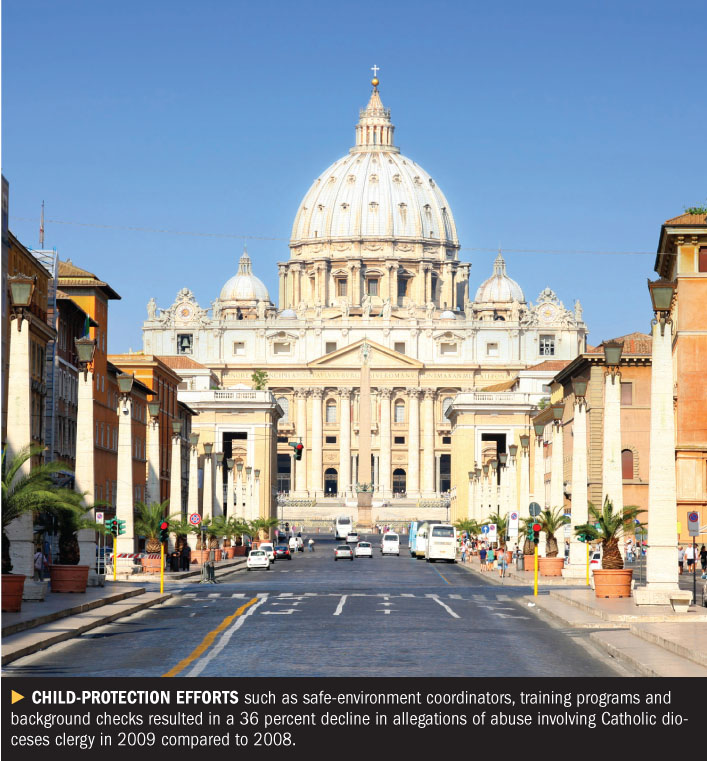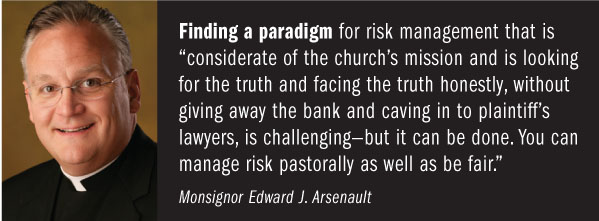By Caroline McDonald
PropertyCasualty360.com
September 29, 2011
http://www.propertycasualty360.com/2011/09/29/catholic-church-risk-management-efforts-reducing
 |
A history of well-publicized events of sexual abuse in the Catholic Church have led to much soul-searching in recent years, resulting in new and improved risk-management guidelines and procedures to protect children and youth.
These changes, according to recent studies, have lowered injuries as well as claims.
The 2010 annual report from the U.S. Conference of Catholic Bishops states that in 2009, there was a 36 percent decline from 2008 in allegations of abuse involving Catholic dioceses clergy.
According to the report, payments for settlements peaked in 2007 at about $450 million. By comparison, settlements in 2010 had dropped to around $54 million.
To get a better understanding of how the church is improving its handling of these and other risks, NU spoke to a priest who also plays an important role in risk management for the church.
“The church, like any other institution, has risks it has to manage,” says Monsignor Edward J. Arsenault, who has been a Roman Catholic priest for 23 years, most recently serving in the Diocese of Manchester, N.H.
Arsenault’s risk-management efforts have been implemented in the state of New Hampshire and also in dioceses across the nation.
Arsenault also is president and CEO of Saint Luke Institute in Silver Spring, Md., a mental-health treatment facility that primarily serves Catholic priests and nuns.
THE RELIGIOUS RESPONSE TO CLAIMS—AND THE LEGAL ONE
“As much as we try to prevent things from happening in the first place, when they do happen, we work with insurers and self-insurance,” Arsenault says.
Such a response to an event would sound familiar, of course, to a risk manager for most any private or public organization.
But, Arsenault observes, the church “generally is not oriented to risk management in a traditional business sense. Our natural pastoral inclination is, if somebody is harmed, you ask, ‘what can I do to help you?’”
This orientation is sharply different from that of lawyers, he adds, whose job is to manage litigation and try to avoid it.
When dealing with crimes against minors, “bishops often have relied on attorneys to help them manage risk—and attorneys build walls” between those with claims and those in the church who would want to minister to the alleged victim, says Arsenault.
He explains that in the past, too often an incident that had been reported “ended up on a lawyer’s desk, who managed it in a way other than how a pastor or bishop would [want to] manage it,” Arsenault says.
And how a lawyer manages a claim is “certainly not how a risk manager would manage it—which is to find out how it happened. And if it did happen, find a way to mitigate the loss and what can be done to resolve it” and how to prevent it from happening again, says Arsenault.
Finding a paradigm for risk management that is “considerate of the church’s mission and is looking for the truth and facing the truth honestly, without giving away the bank and caving in to plaintiff’s lawyers, is challenging—but it can be done,” he says. “You can manage risk pastorally as well as be fair.”
DON’T LET THE EXPERTS DECIDE
As a risk manager in the church, Arsenault says he engages experts—but does not let those experts become decision makers.
In fact, in his view, allowing experts to make the call on claims, instead of church leaders, “is one of the mistakes the church has made” in handling claims in the past.
If the loss is valued at $25,000, for example, “I don’t want to spend that much on a lawyer arguing—and then have to pay for the loss, too,” Arsenault says. “You need to manage all the costs associated with the claim.”
Arsenault emphasizes, “If I had one thing to repeat [to other risk managers], it would be that lawyers should not be decision makers—they are experts. Risk managers can be experts, the claims adjuster is an expert—but there is a tendency when there is a difficult decision to be made to want to put it off on the expert,” instead of where it best belongs, Arsenault argues.
The decision maker, whether it be a corporate officer “or the bishop, has to ultimately accept the responsibility to gather the right kind of expertise and to make a decision, to render a judgment.”
To develop a platform to raise awareness and to orient those who work in the church toward helping create a safe environment for children and young people, Arsenault turned to the expertise of The McCalmon Group Inc. in Tulsa, Okla., which provides training to improve safety in the workplace and lower claims.
“The importance of an organization like that is our best dollars are spent in raising awareness and educating people to risk—because that goes a long way in preventing things from happening,” Arsenault says.
And even when bad things do happen, as they inevitably will, he notes, “you have raised the awareness to a level where the community is ready to respond. They won’t say ‘it’s none of my business.’”
Now, he says, those who work with children on behalf of the church “have been trained that if they are suspicious about the behavior of an adult around a minor they should do the right thing—call someone with authority to look into it. Call the civil authorities. Notify church authorities. This creates a responsible environment that ultimately mitigates the risk.”
He adds, “It’s a lot easier to deal, for example, with a boundary violation by an adult employee with a minor six months after it happens than to deal with it 15 years after it’s happened. So creating that kind of awareness and an environment that’s oriented to education is key.”
The programs that have been created, he says, have “made a big difference in the church. Our claims are much, much lower in terms of malfeasance with minors by adults in the church.”
At least $20.9 million in 2009 was spent by dioceses for child-protection efforts such as safe-environment coordinators, training programs and background checks.
PREVENTION IS KEY
 |
Preventing abuse in the first place is the primary objective of the Catholic Church’s risk-management efforts, says Arsenault.
And one basic but critical way to do that is to screen prospective employees and volunteers.
“I know enough about how nefarious the reality is: People who want to abuse minors identify with organizations that are porous and don’t screen—so we’re not on that list anymore.”
He explains that it is now church law in the U.S. for the Catholic Church that every person who works with minors has to have a background check and must be trained in creating a safe environment.
“There has to be a policy in place in the local diocese where the civil authorities are notified when there’s a report, and where the church is oriented to being helpful to someone who reports being harmed,” Arsenault says.
While the church’s risk-management program is national, “[child abuse] is an international phenomenon as old as the ages and the church is just now trying to get its arms around it as an international issue,” he says.
“I would say the church in the U.S. has taken the lead in developing policies for prevention and assistance for people who may be harmed.”
The policies, he says, are laid out in the Charter for the Protection of Children and Young People. Its second revision was approved by U.S. Catholic bishops in June 2011.
The charter lists steps, followed by directives for carrying them out, to protect children and youth in the presence of adults and to help those who have been victimized. The four steps are:
To promote healing and reconciliation with victims and survivors of sexual abuse.
To guarantee an effective response to allegations of sexual abuse of minors.
To ensure the accountability of the church’s procedures.
To protect the faithful in the future.
View the entire charter outlining the church’s child-protection policy at www.usccb.org.
Any original material on these pages is copyright © BishopAccountability.org 2004. Reproduce freely with attribution.